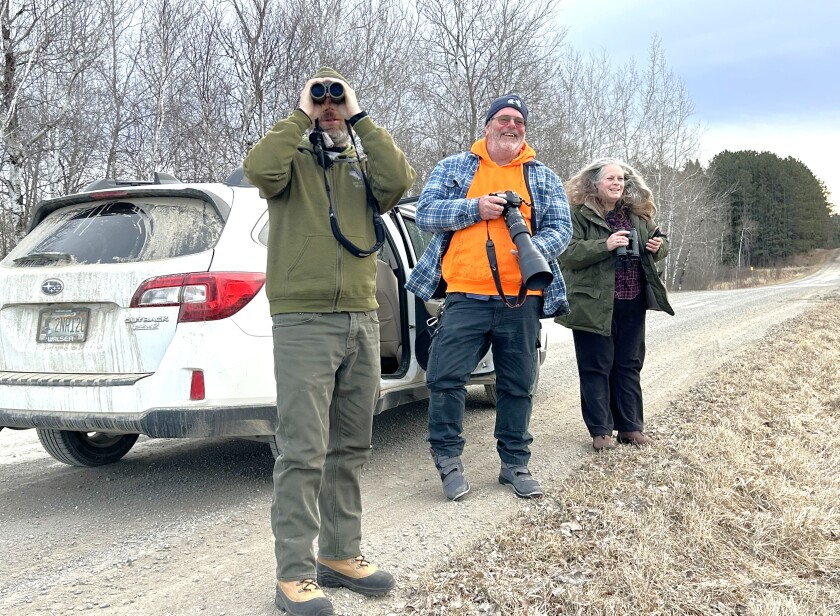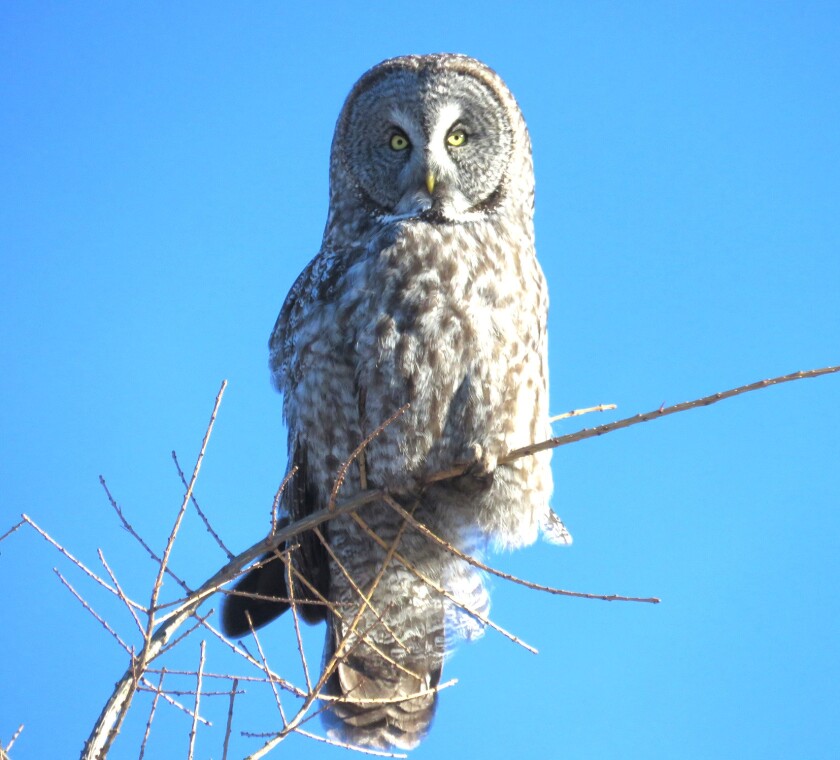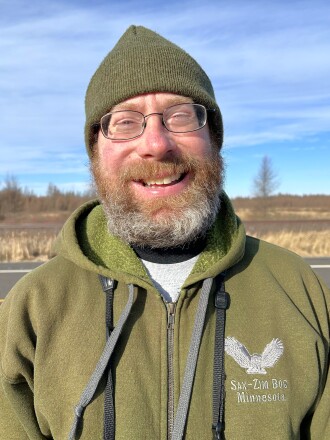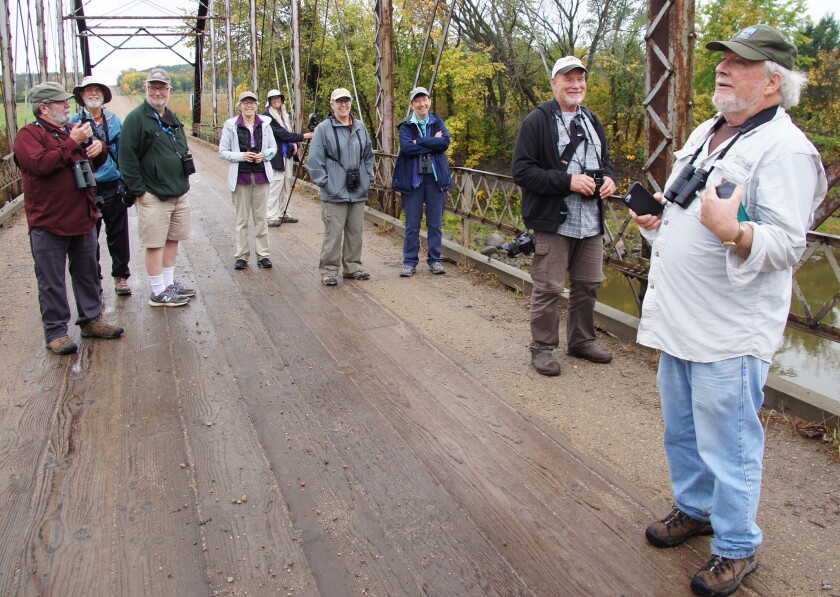MEADOWLANDS — Judd Brink spent nearly 12 hours driving around central St. Louis County in his Subaru on Monday looking for birds, and then he did it all over again on Tuesday.
Brink has been doing this every week since December, when the owls and other boreal birds start congregating in the Sax-Zim Bog, one of his favorite places to take his birding-crazed clients.
“I’ll have 45 guide trips in this winter by the time we wrap up here in March, and many of those are two days. This has been my busiest season so far,” Brink said as he gazed through his binoculars to watch a northern hawk owl perched in a pine tree.

Brink is one of a handful of professional birding guides in northeastern Minnesota — expert ornithologists, naturalists and history buffs who get paid to shuttle birding enthusiasts from spot to spot to see unusual birds, including some species the visitors have never seen before.
While many people in the area remain oblivious to the birding bounty in their midst, the region has become a hotspot for bird-watching tourists from afar, from watching unusual waterfowl along Lake Superior in spring, warblers along the St. Louis River, to the hawk migration over Duluth in fall to the Sax-Zim boreal bird bonanza each winter.
ADVERTISEMENT
And it’s Brink’s job to make sure the visitors get to see what they want, or at least try. Like a fishing guide who can’t make the fish bite, birding guides can’t make birds fly into the open to be seen, and they can’t control the weather, or the migration, or the sunlight that’s available on any given day.

“But they usually can get you close. They save you a lot of wasted time by getting you to the right spots for at least that chance,’' said Scott Ahern who, along with his wife, Cindy, were making their second ever trip from their Pennsylvania home to the bog earlier this this week. Brink also gudied them on a trip here here four years ago.
Owl days
Brink, 49, of Brainerd, spends much of his winter in the bog, about 40 miles northwest of Duluth. It’s one of the best places in the U.S. to see unusual owls that move into the area from the north each winter to hunt voles and other rodents in the open fields and swamps that are surrounded by woods here.
This winter, the watching has been good, with a reliable northern hawk owl hanging around, a fairly reliable great gray owl — the biggest and most popular of the owls — and even a snowy owl (until that critter met its demise with a train late last month).

“It’s one of the best winter birding locations in the country,” Brink said of the bog. But there’s no doubt that “the great gray owl is the No. 1 target bird people want to see.”
While it’s a year-round resident in some years, great grays are much more visible in winter, Brink noted.
Being a bird guide means being ready to roll each morning before dawn, so clients can capture the magic golden hour of bird activity — and perfect photography light — that comes before the sun gets too high. It often involves going until sunset, another active time for some bird species and another great time for photos. In between, there may be a dozen stops to watch birds, more than 100 miles on the odometer, a quick lunch, a few stops to use an outhouse, and side visits to see some other critters like beaver, mink or marten.
On this day, Brink would put his clients within easy sight and close photo range to see some spectacular species — including a fairly rare northern hawk owl, trumpeter swans, a northern harrier, rough-legged hawks, redpolls, eagles and boreal chickadees.
ADVERTISEMENT

“We have some of these, but not all of them, back in Pennsylvania,” Scott Ahern said.
“This is just such interesting country. I’m a nut for the plant communities here, too, not just the birds,” Cindy Ahern noted. "Judd really knows this place."
The couple had driven 20 hours from their home near Philadelphia just to see the bog and its birds. Their biggest goal was a great gray owl, but they smiled at every species they saw.
Brink grew up in the Twin Cities, but settled in Brainerd after attending community college there studying natural resources. He’s become an active member of the Northland ornithology community, a staunch advocate and volunteer for Friends of the Sax-Zim Bog, works for local Audubon efforts and is a certified master naturalist.
He’s part of a silent, mostly out of sight birding tourism industry that helps feed the Northland economy.
“People want a little history along the way. They want to know why they are seeing something here, not just what they are seeing,” Brink said after spreading peanut butter on a log, hoping to lure a pine marten out into the open for his clients to see. ‘It’s focused on birds, but it’s not all birds.”
There’s pressure, to be sure, to meet the client's expectations. Brink often asks upfront for a list of what species the client hopes to see, then works within reason to make it happen. In some years, some species just never show up.
“The best part of guiding is meeting people who have traveled around the world for birding. I enjoy seeing and hearing the excitement and enjoyment of a person seeing their first great gray owl or any first sighting of a bird,” Brink said, noting he enjoys expanding client’s “life lists” of bird sightings. “Many people travel great distances with a financial investment of — traveling, lodging, car rental and food — just to see one or handful of target birds never seen before.”
ADVERTISEMENT

Trailblazing Northland birding guide
Brink has been doing this for 13 years now and seems to keep getting busier. But he’s a youngster compared to Duluth-based birding guru Kim Eckert. Eckert, a Chicago native, quit a school teaching job in South Dakota to move to Duluth in 1977. He became fascinated with the Northland's bird species and started the next year volunteering to take local people out to see unusual species.
Eckert got his introduction to birding thanks to a neighbor growing up and a 10th grade biology extra credit project on birds. Since then he’s become a self-taught birding expert and naturlist. The guiding part came slowly.
“I got a few free rides to go see birds at first, and maybe a free dinner out of it, but it wasn’t much in those early years,” said Eckert, now 77 and slowly retiring out of the bird guiding business.
Eckert eventually realized some people would pay him to take them to where the birds were. He spent more than 30 years working for Victor Emanuel Nature Tours. He was the go-to Minnesota guide for the global tour company whenever they came to the Northland with birding trips.
Eckert agreed with Brink on the clear favorite species among his clients.
“It’s all about owls up here in winter, with great gray the most sought-after by far. Northern hawk owls and snowy owls are next. Boreal owls would be the first priority, except that most winters there aren’t any to be seen,” Eckert said.
Eckert said he tried to keep his rates affordable for people hiring him, about $25 an hour “although some guides charge twice that much,” he noted. (Brink charges $200 per person for a full day, $150 per person for a half day.)
ADVERTISEMENT
In addition to owls, many clients are looking for other birds they can’t see near their homes in more southern or eastern states, Eckert noted, like spruce and sharp-tailed grouse, northern shrike, black-backed and three-toed woodpeckers, boreal chickadees, Bohemian waxwings and finches. “These are all species which are mostly absent south of Canada and the northern tier of states,” he said.
Eckert has guided across the Midwest and into southern states like Texas as well as north into Canada. Most of his clients for Northland trips are from the Twin Cities.
“A lot of them are members of the Minnesota Ornithologists Union who are looking to see species they don’t see at home,” Eckert said. “Most of them are pretty serious birders.”
Eckert said most local guides cooperate with each other. While a few may try to keep secret spots secret, word usually gets out quickly on social media, apps and birding sites when a highly sought or unusual species is around.
“It works better when everyone shares what they see, so it’s pretty friendly,” Eckert said.

More birders, more guides
Eckert said he was often one of just a couple birding guides in the region 40 years ago. Now, more guides are entering the trade every season as demand continues to rise.
“Nobody really knew Minnesota was a place to go birding back in the 1970s,” Eckert said. “Now, it’s a destination. We get people from all over the world.”
ADVERTISEMENT
Brink said this has been one of the busiest winters for birding in the bog in his memory, with crowds of 30-40 people watching the rarest birds at times and traffic jams on gravel roads.
“You never saw that 10 years ago. It was busy even on the weekdays this winter,” Brink said.
Finding birds is the fun part, and usually not the hardest part of the job, Eckert noted.
“It's the logistics of meeting people and getting people where they need to be and meals and finding a bathroom to use,” he said. “It helps to have people skills.”
Most birders have the time and money to spend to go where and when they want, many are retired, and most are pretty nice, Eckert noted.
“It’s like any other kind of people. Some you don’t want to deal with ever again, others you are happy to have them back,” Eckert said. “Nobody gets into this (bird guiding) for the money. You do this because you love the work.”
Brink does most of his guiding in winter and spends much of spring, summer and fall running his “birdscaping” business — MN Backyard Birds — where he helps homeowners landscape their yards to attract birds but also put up custom bird feeders to hold them around.
“I do some guiding in the summer, too, for loons and blue herons and such, if a resort has a family that wants to go out,” Brink said.
ADVERTISEMENT
Brink developed his fascination with birds while growing up along the Mississippi River and landscaping the family yard to attract birds.
“I am doing what I absolutely love to do,” Brink said at one stop in the bog. “It never gets old for me. Every time I see an owl or a hawk or a chickadee, it’s a thrill for me … and it’s a thrill to help others see these birds.”
For a list of Northland birding guides who specialize in the Sax-Zim Bog area, go to saxzim.org and click on Birding the Bog.

















